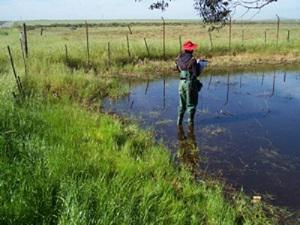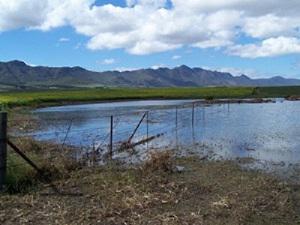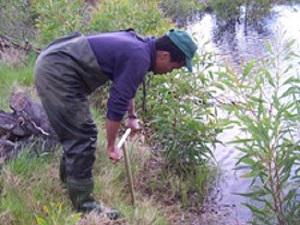Musawenkosi Mlambo
This project aims to establish large scale patterns in biodiversity and distribution of wetland macroinvertebrate assemblages in the Western Cape Province and their correspondence with different landscape classifications.

Musa taking notes.
As the signatory to the Convention on Wetlands of International Importance especially as Waterfowl Habitat (Ramsar Convention) and Convention of Biological Diversity (CBD). South Africa is committed to the management, wise use and protection of its wetland resources. However, very little is known about our wetlands’ extent, distribution, physical and biotic characteristics. We can not hope to conserve the constituents of our biodiversity sustainably unless we know what they are and where they are to be found. Conservative estimates suggest that more than 50% of our wetlands have been destroyed or modified beyond their functional capability.

One of the study site at Piketburg.
Western Cape Province of South Africa harbours one the globally outstanding freshwater ecoregions- the Cape Fold Ecoregion, with exceptional high levels of diversity and endemism. However this unique ecoregion is highly threatened with an array of anthropogenic activities and recent climate change projections have predicted that it will be the worst affected province. Present day biotic diversity and distribution reflect patterns of evolved environmental tolerances, biotic interactions and biogeographic isolation. The latter accounts for variation resulting from speciation and dispersal events which operate over large spatio-temporal scales. It is therefore the aim of this study to assess large scale patterns in biodiversity and distribution of wetland macroinvertebrate assemblages. In addition to being most abundant, invertebrates play a critical role in food web dynamics by providing food source for water birds and fishes.

Musa taking a soil sample.
The objectives of this study are three-pronged:
1) Assess diversity and distribution of macroinvertebrate assemblages of wetlands in the Western Cape Province, by sampling widely and broadly across the province;
2) Establish long-term changes in macroinvertebrate assemblages, by sampling the same wetlands that were studied in the late 1980 and 1990 under different environmental conditions;
3) Assess the usefulness of landscape classification systems (viz. Ecoregions, wetland types and bioregions) in delineating wetland biodiversity.